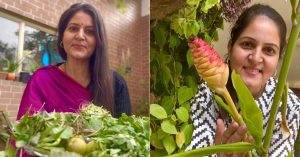Known For Her 3-Mug Baths, Bengaluru Woman’s Simple Framework Shows How to Save Water At Home
For 15 years, Odette Katrak has been striving to save water, even when the Bengaluru water crisis was not in the news. With her framework, she breaks down the notion that tap water is the only water resource in our houses.
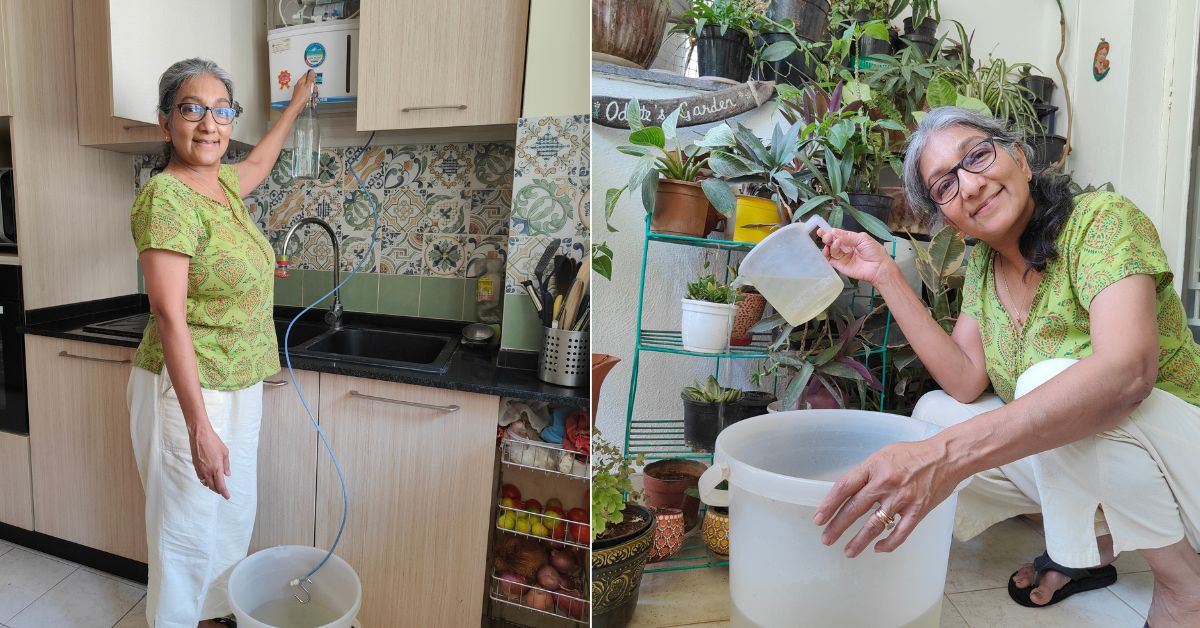
Imagine bathing with just 3 mugs of water or having over 350 potted plants yet not using a single drop of fresh water to water these?
These are some extreme water conservation measures that Odette Katrak, a Bengaluru resident, has been adopting for 15 years, thanks to her unique Ecowaternomics framework, which she hopes will inspire many to save huge amounts of water too.
“It took us a severe water crisis in Bengaluru to realise we need to save water,” she remarks. With thousands of public borewells running dry, strict restrictions and penalties being imposed on the wastage of water, Bengaluru is facing a dire scarcity of water.
“While residents are chasing water tankers and taking fewer showers, many expect external solutions like rainwater harvesting, Sewage Treatment Plants (STP) etc that increase supply, instead of parallel changes in the household that reduce demand. Maybe they find it difficult – that’s where my framework helps,” she adds.
Meanwhile for Odette, the genesis of water conservation set off 15 years back when she saw a chilling presentation ‘Letter in the year 2070’. It described a world without water, where you would get just one glass of water to drink, be forced to shave your head, and rub oil on your body.

“Those images shook me, forcing me to cut back drastically. Bathroom singing during earlier lengthy baths was something I had to give up,” she laughs.
Moving to Bengaluru nine years back gave her more reasons to save water. “My house overlooked low income dwellings. I’d see women fetching water. One was even carrying her infant, who was also armed with an empty bucket. With even small children being made to carry water, this gave a totally new value to how precious water is,” she tells The Better India.
“These images placed a responsibility on me to save water judiciously. So, even though water flows abundantly from my taps, it is also my responsibility to conserve water as it is a shared resource. This was also a turning point for me to not only save water in my home but also make others understand that just because we can afford water tankers, it doesn’t mean we are free to keep wasting water,” she adds.
To address the colossal neglect of water at the household level, the 60-year-old has created a one-of-its-kind framework that can help residents slash fresh water usage. With this simple approach, she claims to use around 1500 litres less water per day than an equivalent household.
She aims to make water-saving simple, and with a measurable outcome – everyone opens taps less for fresh water, while still having enough for their needs with her ‘Use less, Reuse More’ formula.
Three-mug bath challenge
Growing up in a family of nine in Chennai, Odette learned to make do with a bare minimum amount of water, to tide over summer shortages. “But when I started living on my own, I forgot these practices till I came across that eye-opening video in 2009,” she says.
Understanding the need to conserve water, Odette started bathing using three mugs of water. Nearly five years back, she became well-known for this. “I bathe with three mugs of water and yes, I don’t smell,” she adds laughingly.
“A friend joked that no wonder autocorrect changes Odette to Odour! Others teased that they would cover their nose if they run into me in the future. All taken in good humour, which helps get attention to this subject. I respond that it is good if people think I use too little, they may start realising that they use too much!” she says.
Odette, who is the co-founder of Beautiful Bharat — a citizen-led movement to bring about a systemic social change in the mindset of people — runs a Save-water campaign that includes a Minimum Water Challenge.
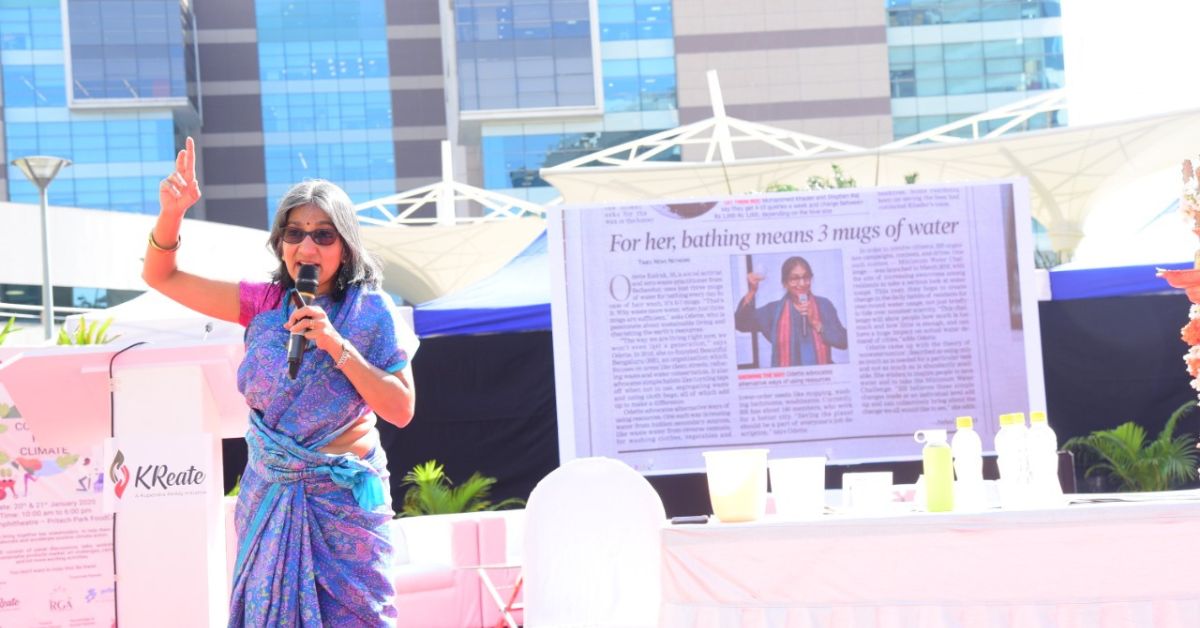
“With my three-mug challenge, I have managed to put the idea in people’s minds that three mugs of water is enough to bathe. Why use 20 litres of water, if three mugs will do! Earlier, I would use three mugs of water for regular baths and six mugs when washing my hair. Now I can do with three mugs for washing hair and two mugs for regular baths. I collect that in a tub to use for flushing,” she says.
With this, Odette says she has been able to bring her water consumption while bathing down from 75 litres to 3.6 litres daily. In fact, that water is also further reused, demonstrating her ‘Use less, reuse more’ mantra in action.
Slash water usage with simple framework
Odette categorises the usage of water into a framework she calls ‘Ecowaternomics’, a water needs hierarchy, similar to Maslow’s hierarchy of needs, based on a hierarchical order.
She defines the concept as being economical with water usage, using only the bare minimum that one needs, and not as much as is abundantly available. This can be achieved by two principles: use less and reuse more. Using less is obvious but needs reminding (low tap flow, tap off when not needed, no running water, and no leaks).
Her next question, “Would you bathe with mineral water?” emphasises the second part of her formula – to reuse more. “We wouldn’t waste water of higher purity to bathe, yet we all use fresh water out of a tap for washing mops or rinsing dirty dishes when water of lower purity works just as easily,” she adds.
Based on her calculations, she says most households require fresh water for only 30-40 percent of their needs, remaining water needs can be met by reusing this water. “Water that you let down the drain is always good for some other purpose,” she suggests.
She points out the hidden sources of water available at the household level: water from washing hands, rice/pulses, fruits and vegetables, waste RO water, water from defrosting, and washing machine outlet water. “While these are not fit for drinking, they can be reused for other purposes, even if clear, cloudy, soapy or muddy,” she adds.
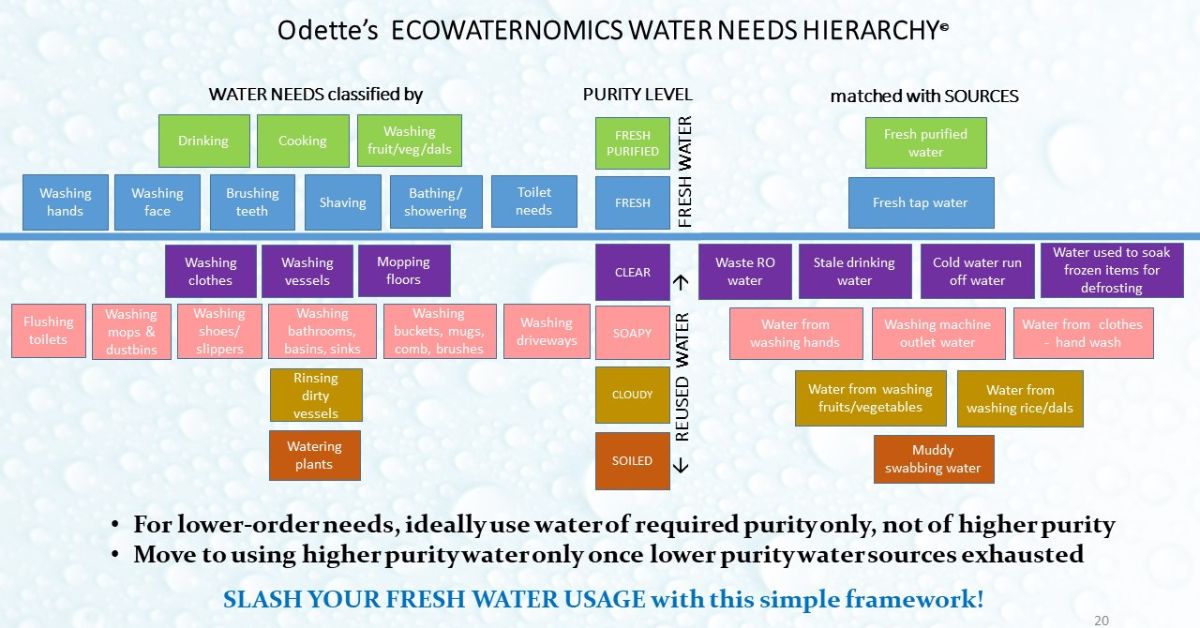
(See slide: Ecowaternomics framework)
For instance, Odette adds that while you use fresh purified water for drinking, cooking, and washing fruits and vegetables, you can use fresh tap water for washing hands and face, brushing teeth, shaving, bathing, washing clothes, and toilet needs. Other than these purposes, you can reuse water.
“For every one litre of filtered water, RO wastes three litres of water. Sadly, many let this down the drain but it is still clear water so can be used to mop floors and wash vessels,” she explains.
“Applying the hierarchy of needs principle, I cannot bring myself to use clear RO waste water on plants, as cloudy water collected from washing vegetables/dals works perfectly here or for rinsing dirty dishes – again why use water of a higher purity than needed! I use the rejected water from the RO for mopping and then reuse it again for watering plants, possible because I use organic cleaners,” she adds.
Interestingly, Odette makes organic cleaners that make the water safe to reuse.
“In place of toilet cleaners and floor cleaners, I use homemade bio enzymes that can be used to clean bathrooms, floors, and disinfect fruits. I reuse this to water my plants. Bio enzymes are beneficial for plants as it acts as a fertiliser,” she says.
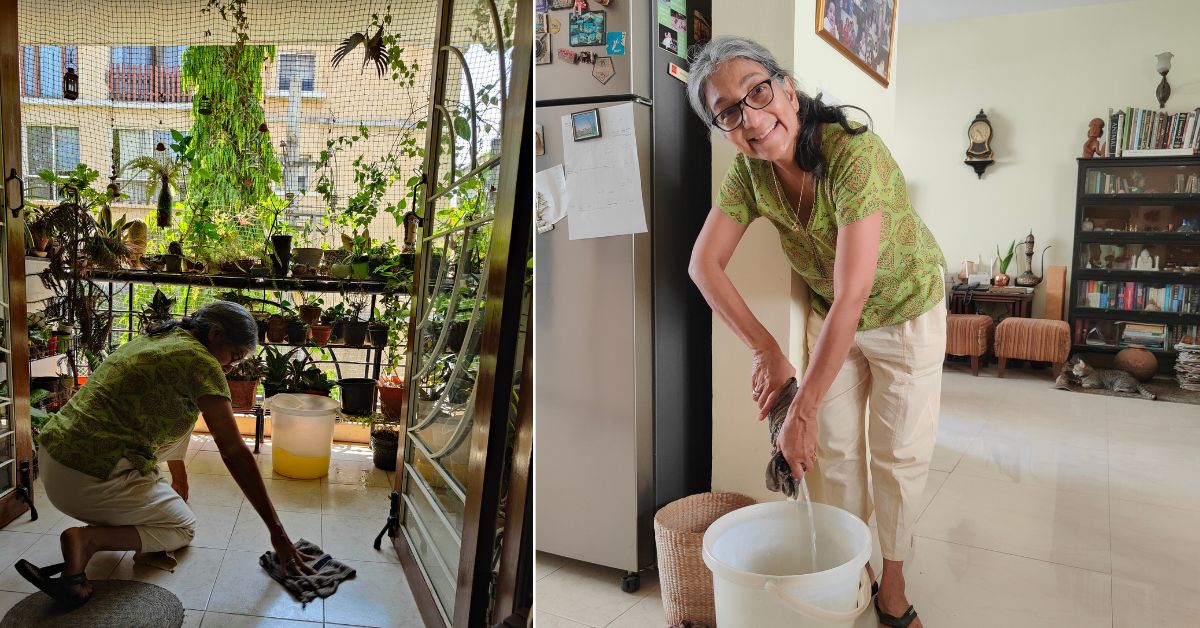
To make this organic cleaner, Odette says, mix three parts of fruit peels with one part of jaggery in 10 parts of water in an airtight jar, stirring daily to release gas. “After six weeks, it’ll be ready to use. It also leaves a beautiful aroma,” she adds.
Meanwhile, soapy water from washing hands, washing machine outlets, and clothes can be used to flush toilets, washing mops/dustbins, bathrooms, washbasins, buckets, driveways, etc.
Next, Odette advises collecting cloudy water from washing fruits, vegetables, rice and pulses to be used for rinsing dirty utensils. Lastly, muddy water from mops can be used to water plants.
Odette was asked, years back, if there is any need to go to this extreme, for isn’t this all too drastic? “If we all do more of this now, future generations will not be forced to do this all the time,” she had replied.
And that scenario is nearer than anyone expected, she says. If you found our stories insightful, informative, or even just enjoyable, we invite you to consider making a voluntary payment to support the work we do at The Better India. Your contribution helps us continue producing quality content that educates, inspires, and drives positive change. Choose one of the payment options below for your contribution- By paying for the stories you value, you directly contribute to sustaining our efforts focused on making a difference in the world. Together, let’s ensure that impactful stories continue to be told and shared, enriching lives and communities alike. Thank you for your support. Here are some frequently asked questions you might find helpful to know why you are contributing?

“Not just Bengalureans, but saving water is something everyone across cities could make a year-round habit – water levels are depleting everywhere. Why wait for a water crisis to start. Let’s use water as carefully as we would if we had to first carry it, like those women that I’d described. Because every drop does count!” she concludes.
To support Odette’s campaign to save water and similar campaigns for the environment and a Beautiful Bharat, connect on Instagram @odettekatrak or @beautifulbharatorg.
This story made me
- 97
- 121
- 89
- 167







